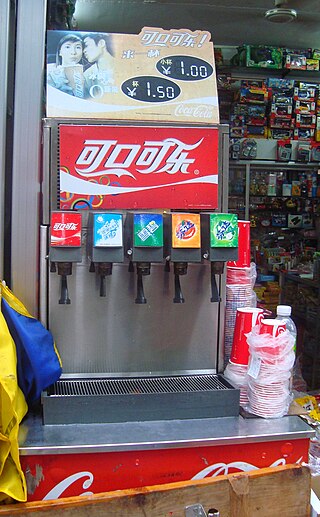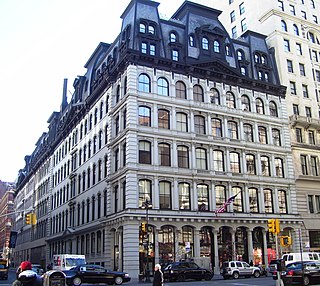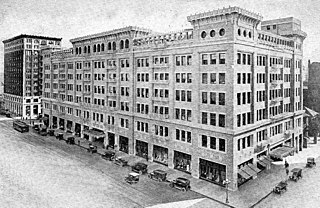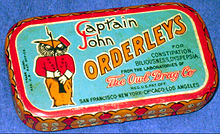
A soda fountain is a device that dispenses carbonated soft drinks, called fountain drinks. They can be found in restaurants, concession stands and other locations such as convenience stores. The artifact combines flavored syrup or syrup concentrate and carbon dioxide with chilled and purified water to make soft drinks, either manually, or in a vending machine which is essentially an automated soda fountain that is operated using a soda gun. Today, the syrup often is pumped from a special container called a bag-in-box (BiB).

W. & J. Sloane,, was a chain of furniture stores that originated from a luxury furniture and rug store in New York City that catered to the prominent, including the White House and the Breakers, and wealthy, including the Rockefeller, Whitney, and Vanderbilt families.

The Harris Company was a retail corporation, based in San Bernardino, California, that operated a chain of department stores named Harris', all in Southern California. Philip, Arthur, and Herman Harris – nephews of founder Leopold Harris of what was once the large Los Angeles–based chain Harris & Frank – started the company with a small dry goods store in 1905, and the company eventually grew to nine large department stores, with stores in San Bernardino, Riverside, and Kern Counties.

J. W. Robinson Co., Robinson's, was a chain of department stores operating in the Southern California and Arizona area, previously with headquarters in Los Angeles, California.

Thrifty PayLess Holdings, Inc. was a pharmacy holding company that owned the Thrifty Drugs and PayLess Drug Stores chains in the western United States. The combined company was formed in April 1994 when Los Angeles–based TCH Corporation, the parent company of Thrifty Corporation and Thrifty Drug Stores, Inc., acquired the Kmart subsidiary PayLess Drug Stores Northwest, Inc. At the time of the merger, TCH Corporation was renamed Thrifty PayLess Holdings, Inc. and Thrifty operated 495 stores, PayLess operated 543 stores.

Bullock's was a chain of full-line department stores from 1907 through 1995, headquartered in Los Angeles, growing to operate across California, Arizona and Nevada. Bullock's also operated as many as seven more upscale Bullocks Wilshire specialty department stores across Southern California. Many former Bullock's locations continue to operate today as Macy's.
I. Magnin & Company was a San Francisco, California-based high fashion and specialty goods luxury department store. Over the course of its existence, it expanded across the West into Southern California and the adjoining states of Arizona, Oregon, and Washington. In the 1970s, under Federated Department Stores ownership, the chain entered the Chicago, and Washington, D.C., metropolitan areas. Mary Ann Magnin founded the company in 1876 and named the chain after her husband Isaac.

The City of Paris Dry Goods Company was one of San Francisco's important department stores from 1850 to 1976, located diagonally opposite Union Square. In the mid-20th century, it opened a few branches in other cities of the Bay Area. The main San Francisco store was demolished in 1980 after a lengthy preservation fight to build a new Neiman Marcus, but the store's original rotunda and glass dome were preserved and incorporated into the new design.

The Joseph Magnin Company was a high-end specialty department store founded in San Francisco, California, by Joseph Magnin, 4th son of Isaac Magnin founder of the I. Magnin department store. Joseph Magnin Co. and I. Magnin Co. were rivals.
Caswell-Massey, founded in 1752, is the first fragrance and personal care product company in America. Originally, Caswell Massey started as an apothecary shop in Newport, Rhode Island, by a Scottish-born doctor named William Hunter. The main product categories include fine-fragrance, soap, bath & body products, men's shaving products and toiletries and other assorted apothecary-style personal care accessories. Its products were preferred favorites of notable historical figures such as John F. Kennedy, George Washington, Cole Porter, Alla Nazimova, John Denver, and The Rolling Stones.
Akron Stores or The Akron was a Southern California–based imported goods and home decorating department store retail chain established in 1947 and was known to carry unusual merchandise, mostly imports. The chain had over 24 stores throughout Southern California from San Diego to San Francisco before it was forced to close in 1985.

Hale Brothers Department Store, was a department store headquartered in Sacramento, California, with branches throughout the San Francisco Bay Area.

Walker Scott, also Walker-Scott or Walker's, was a chain of department stores in San Diego and surrounding area from 1935 to 1986 and had eight branches at the time of its closure. It was founded by Ralf Marc Walker and George A. Scott.

Blocki is an American fragrance brand and one of the earliest perfume and cosmetic manufacturers in the United States. It was founded in 1865 by perfumer John Blocki, a pioneer in the American fragrance industry.

Valley Plaza was a shopping center in North Hollywood, Los Angeles, one of the first in the San Fernando Valley, opened in 1951. In the mid-1950s it was reported to be the largest shopping center on the West Coast of the United States and the third-largest in the country. It was located along Laurel Canyon Boulevard from Oxnard to Vanowen, and west along Victory Boulevard. Like its competitor Panorama City Shopping Center to the north, Valley Plaza started with one core development and grew over time to market, under the single name "Valley Plaza", a collection of adjacent retail developments with multiple developers, owners, and opening dates.

Parmelee-Dohrmann was a Los Angeles–based chain of stores that sold fine china, crystal, glassware, silver, and objects of art.

Orange County Plaza, later Garden Grove Mall, Garden Promenade, now The Promenade at Garden Grove, was, upon its expansion in 1959, with sixty stores, the largest shopping center in Orange County, California, and at the time billed itself as "Orange County's first regional shopping center". However, Anaheim Plaza had in fact already opened In 1955, four years prior, and had an anchor department store.

Swelldom was a large women's clothing store variously described as a "cloak and suit house" and a "department store", operating from 1906 until the 1970s in California. It had locations on Broadway in Downtown Los Angeles' shopping district, later on Wilshire Blvd. at Camden in Beverly Hills, and near Union Square in San Francisco.

Thriftimart was an American chain of supermarkets in Greater Los Angeles until 1984, founded by Roger M. Laverty. Many stores continue to operate as Smart & Final stores, now owned by Mexico City-based Chedraui.


















